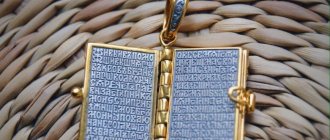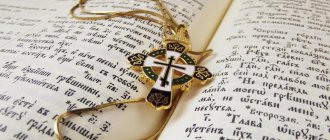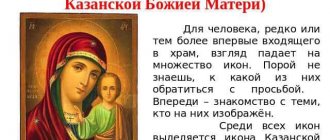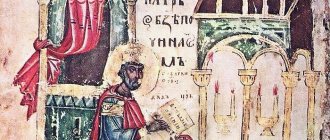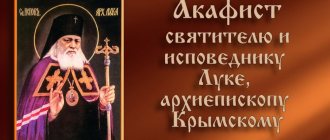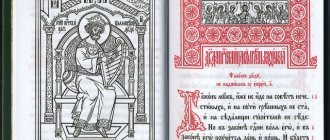February 12, 2015
Knowing only one language in our time is an unacceptable liberty, significantly limiting career growth, and therefore financial well-being. But in the pursuit of money, we often forget about the spiritual. And there is only one language, by studying which you can rise a step higher spiritually and better understand your roots. This language is Church Slavonic.
For several decades, the majority of the inhabitants of our country fearfully shied away from the church, not even knowing how to enter the temple. Now there is a reverse process - the process of converting atheists into Orthodox Christians. But this is not a quick path. Newcomers who come to church at first do not understand the church language at all. And more and more often we hear proposals to replace the Church Slavonic language with Russian, so that more people understand church affairs, and therefore feel more comfortable in the church. However, this opinion has serious opponents who clearly argue their position.
Dostoevsky, Tolstoy, Pushkin, Tyutchev, Lermontov, Bunin and other great Russian writers knew the Church Slavonic language very well. Academician D.S. Likhachev called it the language of noble culture, in which there are no dirty words at all and in which it is impossible to swear. And it is this language that clergy use to address God and the Mother of God - a pure, noble, non-vulgar language.
How did the Church Slavonic language appear?
The Church Slavonic language was transformed from the Old Church Slavonic language. He and his alphabet (Glagolitic) were created by the Solunsky Brothers for all Slavs. It was used:
- Czechs,
- Slovaks,
- Moravians,
- Poles,
- Croats,
- Bulgarians,
- Serbs... i.e. all Slavs.
Cyril and Methodius spoke this language. Gradually, the Old Church Slavonic language was simplified and enriched with borrowings, which greatly worried progressive scientists. Thus, M. Lomonosov wrote back in 1757:
“By diligently and cautiously using the native Slavic language, which is native to us, together with Russian, we will ward off wild and strange words of absurdity that come to us from foreign languages.”
Immersion in Church Slavonic
Pushkin exclaimed passionately: “My children will read the Bible in the original with me.” “In Slavic?” – asked Khomyakov. “In Slavic,” Pushkin confirmed, “I will teach them myself.” Metropolitan Anastasy (Gribanovsky). Pushkin in his attitude to religion and the Orthodox Church
The Russian rural school is now obliged to impart to its pupils knowledge of the Church Slavonic language... this is a pedagogical treasure that no rural school in the world possesses. This study, constituting in itself an excellent mental gymnastics, gives life and meaning to the study of the Russian language. S.A. Rachinsky. Rural school
The Church Slavonic language is the basis of the Russian language. It is safe to say that someone who does not know Church Slavonic cannot truly know Russian. The Church Slavonic language is the key to traditional Russian culture, without which we will only be admiring a closed, albeit beautiful door, “getting to know the culture,” but not joining it. Church Slavonic is the language of Orthodox worship, the main translation of the Holy Scriptures into our language and the language of the Russian theological tradition. The Church Slavonic language is the simplest and at the same time effective means for a Russian-speaking child to get acquainted with the basics of linguistics.
How to introduce children to the world of the Church Slavonic language and make it their native language ? You can buy textbooks for learning this ancient language, send them to the appropriate school, or conduct daily lessons yourself, to the best of your ability and ability, forcing the child to decline words by case. But this way you can prepare for passing the exam, but this is not enough to make a child related to the language. Don’t know the rules of grammar, have no idea what an aorist is, and at the same time... think in Church Slavonic. Is it possible? I think so. You can first introduce the child to the language, and then, to the extent possible and necessary, he will also master the grammar of the Church Slavonic language that is already close to him.
Living the Church Slavonic way
To include a child in the circle of Church Slavonic culture, one single very important condition is necessary: the family must live this culture, that is, live the life of the Orthodox Church. If this is the case, serious efforts will not be required to master the Church Slavonic language; if this is not the case, any efforts will probably be ineffective and will not make much sense. But a child cut off from the Church Slavonic language will certainly not be able to truly master Russian, and without life in Orthodox culture he will be deprived of the richness of all Russian culture.
The very first and main immersion in Church Slavonic is joint prayers of children and parents, singing prayers, for example in the morning, before meals, at night. We always do this and not at all for the sake of learning anything, but this is already “immersion in the language” - the most effective method of teaching any language.
A child’s study of the Holy Scriptures is a separate topic. Here we will talk about how to “immerse” a child in the Church Slavonic language. Just read the Bible in Church Slavonic ? Necessarily. However, not only a child, even an adult cannot always easily understand an unfamiliar Slavic text by ear. This is how we do it. First, I myself read the relevant passage from the Bible, for example, the story of Cain and Abel (at the same time, it is useful to turn to the interpretations of the holy fathers on this place, but this is again a different topic...). Then I tell the children this story in my own words. Then we look at how this story is written in the Bible - we read in the Synodal translation. And the next day, dad solemnly reads this same passage in Church Slavonic. And now everything will be truly clear, because all unfamiliar words and expressions will be perceived in a well-known context. After reading, you can ask the children what is not clear, discuss these passages, and, if necessary, look at the Russian translation again. Surprisingly, in fact, even five or six year olds can really understand everything.
You can draw attention to interesting words and their origin. For example, “the eyes were opened” - that is, “the eyes were opened.” “Opened” seems to have opened, as we now talk about doors. Eyes - eyes, from this word comes the word “glasses”, the word “obviously” - what is “visible to the eyes”. In difficult cases, it is convenient to use dictionaries - for example, the “Complete Church Slavonic Dictionary” by priest Grigory Dyachenko, it is probably the most accessible; also “Dictionary of the Old Russian Language of the 11th–14th Centuries” or “Dictionary of the Church Slavonic and Russian Language”, compiled by the Second Branch of the Imperial Academy of Sciences (St. Petersburg, 1847). You can also turn to other dictionaries - everything can be found on the Internet[1]. Such work with words will be an education not only for children, but also for adults . I don’t know the answer to the question asked by the child, and in searching for this answer I myself learn new things. And not just new - by revealing the meaning of the word, I delve into its meaning, and in this case it is the meaning of the texts of the Holy Scriptures. Another very important aspect: the child sees that if mom and dad don’t know the answer, they don’t just state this fact or, God forbid, are ashamed of their ignorance - they look for the answer until they find it, and this teaches the child to treat his own accordingly. ignorance. We show the child the way - where exactly to look for the answer, he learns about the existence of dictionaries and encyclopedias, learns to work with them both in “live” and electronic form, learns to look for words with the same root and find unexpected sounds and meanings of known words and frozen expressions.
Touching the etymology of Church Slavonic words, especially in Bible translations, we are sure to encounter the Greek original, since many of the words here are calques from the Greek language. With older children, reading this or that passage of Scripture, you can see in what cases the Synodal translation differs from the Slavic - and sometimes it differs seriously - and then turning to the Greek original (and the oldest copies of the New Testament, like the one made before Christmas Christ's translation of the Old Testament - the Septuagint, written in Greek) will also help us penetrate deeper into the meaning of the text and at the same time allow us to become better acquainted with Church Slavonic. In this way, children will learn about the problem of translations into another language in general and the problem of translating the Holy Scriptures in particular, and about the enormous importance of language in ideas about the world, man, and God.
You might think that only a specialist can do all this - far from it, the point is precisely that when preparing for such a special lesson, parents will study either together with their children, or study in order to teach their own children .
Invading the area of translations, we inevitably encounter the problem of the meaning of the word, that is, in this case, with theology. In order not to get confused in your research, it is necessary, when analyzing the corresponding passage of Scripture, to turn to the patristic interpretation or to your confessor. And this is another way to study the Slavic language - already as the language of Russian theology.
So, trying to read a few verses from the Bible with the children, we will introduce the children to the Church Slavonic language, and teach them how to work with the text, and we ourselves will learn all this, or at least begin to learn. Sometimes such reading with our children lasts for several days and continues without the children, when we, parents, look for some interesting passage in different translations, look at what St. John Chrysostom, or St. Basil the Great, wrote about the meaning of the corresponding text, or Saint Theophan the Recluse... And this is great, this is interesting, this gives new opportunities to continue working with children.
Word and letter
To teach a child not only to understand our ancient language, but also to read in it, it is not necessary to arrange lessons according to a schedule, interspersing them with tests and assigning grades. A child can learn to read Church Slavonic without even noticing it when the lessons are integrated into the regular life of the family.
The first acquaintance with reading in this amazing language should help the child perceive the image of Slavic letters as understandable and close. Probably the simplest thing is to write the baby’s full name in Church Slavonic letters . You can find out how it is written correctly by looking at the icon depicting the heavenly patron of the little student. I write the name clearly, large, the first letter in red and gold. This way you can sign Christmas gifts - and the Church Slavonic script will evoke associations with holiday and surprise. You can sign your child’s books – preferably beautiful ones with appropriate content. During family holidays, sign the seats at the table like this. The baby may not even be able to read Russian yet. A child who cannot read does not spell his name - he perceives the whole word. They told him that these beautiful black squiggles, and the red and gold one in front - this is “Nikolai”, and he understands: this is “me”. If then the same word appears in other cases - on the flyleaf of a book about Father Seraphim given to the child, on a sketchbook - then gradually this set of letters will become familiar and will be perceived by the child as property.
The next step - or lesson: the child prepares a drawing or appliqué as a gift to his grandmother for the next holiday. To sign the drawing, the mother writes the child’s name large in Church Slavonic with a simple pencil, and the baby traces it with a felt-tip pen . This word must be pronounced out loud several times, tracing the letters with the baby’s finger, then marking each symbol circled by the child: “N”, “I”, “K”, etc. Now the child does not see beautiful squiggles merged into a single image, but begins to recognize them as a combination of different icons, which are all together - “I”, “Nikolai”. We can consider that the first acquaintance with the Church Slavonic language took place.
A child who already knows a little how to draw himself can beautifully design some small inscription, for example Easter, for a home iconostasis. If a child can read Russian, with the help of such a small phrase he will learn not to perceive the special graphics of Slavic as incomprehensible - like, I can’t read like that. Yers and yati are easily read in a familiar phrase . We gradually offer the child longer and longer phrases to copy, but these should always be sentences familiar to the child. It seems to me that it is easier and more interesting not to sit the child down for such a “Church Slavonic lesson”, but to make decorations for the home, sign homemade cards and posters. In order to write a phrase correctly - and to place obtuse and sharp accents, to determine where and where, even a certified specialist is not always able to - the easiest way is to copy phrases from Scripture or prayer books in Slavic, and my mother copies from the prayer book in large and beautiful letters on a piece of paper , and the baby is already copying from it.
First - reading, then - alphabet
Probably, the main difficulty in such a simple mastery of this difficult language by a child turns out to be titla - abbreviations of words - “Lord, have mercy.” At the end of many prayer books in Church Slavonic there is a list of basic words that are written under the title. But in general this is not a problem, you just need to explain to the baby that this is the word “Lord”, but it is written like this, abbreviated. We do not offer the child to immediately read the entire Psalter, we offer only one phrase for now, and the child begins to perceive the word under the title as a whole, as an image, as he once perceived his name. You just need to read the phrase to the baby, moving your finger over the text, and then pronounce each word that the child is now writing.
Orthodox bookstores sell Church Slavonic copybooks - for example, by Elena Makarova, Irina Goryacheva. These manuals can also be used as preparation for regular school. Such copybooks suggest writing out the elements of letters, circling letters, writing them in boxes - this prepares the hand for writing, teaches attentiveness and accuracy. And at the same time, such activities allow the child to master the Slavic alphabet. By writing this or that letter - sometimes just once, sometimes in two lines - as the child himself wants, we pronounce its name: verb, live, think. Ornaments from such copybooks can be painted as a coloring book; they can be used as a sample when creating thematic crafts. At the same time, working with copybooks easily fits into the daily routine. After all, when older children sit down to do homework, preschoolers often try to imitate them - also sit at the table, get a notebook and pen, but it happens that they interfere with their older children with their active games. Now they also receive an assignment in the Slavic script - both an adult task and silence.
The first letter in the text is usually special - it is a separate fantasy picture called a drop cap. Sometimes it is just a letter decorated with patterns, but it can also be made up of images of plants, even animals and people, or it is a simple letter, but inscribed in a plot picture. Images of these initial letters can be easily found on the Internet and you can invite your child to draw “his” letter like this - the initial letter of his name. Even for a three or four year old child, you can print out the initial letter or draw it with a pencil for the child to color it. But next to the initial letter it is necessary to place a small, ordinary image of the same letter so that the baby can see it hidden in the patterns. This way you can gradually draw all the letters of the alphabet, just sometimes asking your child to color the letters instead of coloring.
To easily and effortlessly master the Slavic alphabet, working with copybooks and drawing initial letters can be combined with making the alphabet. To do this, it is good to make or buy a poster with the image of all the letters, where each is signed: az, beeches, lead... On an A3 or A2 sheet of paper, the mother draws these letters or only their outlines, so that the child can color them himself. The poster is hung either above the baby’s bed - not at the head, where there is a place for icons, but so that, lying in bed, the child can clearly see the alphabet. You can attach this sheet above your desk, above the kitchen table - in a place that your baby will often see. This alone will allow the baby to slowly learn the alphabet. For the best effect, you should, firstly, make the poster together with the child, and also read the names of the letters out loud at first to attract the baby’s attention. In the future, we satisfy the slightest interest of the student in this poster. For example, a child asks me: “Do you remember there is a worm letter there?” “Not a worm,” I answer, “but a worm, here she is depicted. Can you draw it? And right there, before interest wanes, I offer a piece of paper and a felt-tip pen, and the child, independently or with his mother’s help, draws the letter. The child himself showed interest, which ensures attention to the topic, so the mother’s answer is well absorbed. We show the letter on the poster - and the child now knows the “place” of this sign. Drawing consolidates the acquired knowledge. In the evening, for example, when meeting your dad from work, you can return to the topic again: “Dad, today our Sasha learned an interesting letter. Sasha, show dad your drawing, tell me what this letter is called.” This will be a “repetition of the past.” For older children who can read, it is enough to simply hang up this poster - the alphabet will always be before their eyes, and in hours of fun or idle boredom, children will read the same names and, over time, remember them.
Why do we suggest learning the alphabet after we have actually started reading? If desired, these stages can easily be swapped. But when reading by words, and not by letters, the baby perceives the word as a whole, as a single image, which is especially important for reading under titles, while reading by letters can rather create an obstacle to the holistic perception of the word. This is especially true for children who have not yet mastered reading in a modern language. It is easier for a preschooler to understand the symbol of a familiar food than to perceive the abstract symbol of a letter and connect it with other abstract symbols.
With prayer without cramming
If a family lives a church life, then before meals the prayer “Our Father” is read or sung, at least once a day everyone prays together and, of course, the initial prayers are read first. In this case, a five or six year old child should already know these prayers by heart without special memorization. If he doesn’t know, then you need to start praying with the whole family, and in a few weeks the baby will definitely remember these short texts by ear. The uniqueness of home education is clearly visible here: the child learns without memorizing the text “to answer at the blackboard,” but memorizes prayers during prayer, receiving as an example the behavior of the most significant and authoritative adults - parents, which makes the child’s education inextricably linked with life.
At 5–6 years old (parents can themselves feel the degree of readiness of the child), you can invite the child to make a children's prayer book. It’s logical to tie this craft to some real need: for example, the baby will have to spend the night with his grandmother, who has little church. “How will you pray at night and in the morning? Let's make you a prayer book. If you forget something, the book will remind you.” In this prayer book we write down only really simple and short prayers that are well known to the baby. Our task is to write exactly what the child knows by heart. For what? Firstly, the fear of reading in general will be overcome if the child cannot read, or reads poorly, or reads only in Russian. Secondly, reading the Church Slavonic text, whatever one may say, is still not the easiest thing a small child can master. And in this case he is more likely to guess a familiar text by some familiar outlines of the letters. This guessing makes it easy to master writing under titles.
In the first prayer book of a five or six year old child, it will probably be enough to write down the initial prayers. It’s good to add a prayer to the baby’s patron saint, the shortest one - “Holy Great Martyr Catherine, pray to God for me.” The outline of the name should already be well known to the child, and besides, his own name in the prayer book makes this book his own, close.
This prayer book, of course, should be beautifully designed. You can take thick paper, for example for drawing. Fold in half, make a small frame inside on the resulting leaves, line with a simple pencil - so that later you can erase these auxiliary lines. Then everything depends on the baby, how old he is, how well he can write in Russian. Either the mother writes the entire text herself with a simple pencil, copying it from the prayer book, and then the baby traces it with a black felt-tip pen, or the child himself copies the prayers from the same book. Most likely, the enthusiasm will disappear after a few lines, and in this case I do not force the children to continue - we finish the line and postpone this matter until next time. Such a craft takes several days and even weeks, so it is better to prepare in advance for such a trip to grandma... The fact that the words were written by the child himself also turns out to be an overcoming of fear of the text: after all, if I wrote it myself, how can I not read it?
We make the first letters in each prayer beautiful, red. The margins of the prayer book can be decorated with ornaments, a cross or an icon can be drawn or glued on the cover, or simply beautifully written “Prayer Book” or “Catherine’s Prayer Book”. Here we can invite the child to choose the decoration for his first homemade book, because we want the child to like this craft.
Even if a child has barely learned to read the letters, when he gets up for family prayer, he will pick up this homemade prayer book and run his finger along the lines, even if he does not understand what is written there. You can suggest what prayer we are singing now (usual answer: “I know!”). By comparing the well-known words of the prayer, which is currently being read or better - because it is sung more slowly - with the written text, the child eventually begins to simply read automatically. First, he remembers that the big red letter “C” is a prayer to the “Heavenly King,” then little by little the words become clear. If this book is made too early, the child does not know how and does not want to read, then most likely he will play at being an adult, pretending to read, and quit. But some five-year-old children can actually read their Church Slavonic prayer book within a week or two. A child who has made such a craft at the age of seven or eight reads such a prayer book immediately and on a “trip to grandma” actually reads this book. This means that the styles of letters and the peculiarities of writing words are already easy for them to understand. Consequently, the child can already read almost any Church Slavonic text. We can say that now the child can read Church Slavonic.
What's next? It makes no sense to write new prayer books when there is such an abundance of printed ones. Using them, the child can read the morning and evening rules, prayers for communion. As a child, I had a prayer book in Slavic. However, I must admit that although my children use books in Slavic, they prefer prayer books with modern Russian letters. And in my opinion, this is not a problem, because the main thing is that the child prays, that he loves prayer and understands its meaning.
What's next?
To ensure that children continue to master Slavic literacy, we periodically write texts in this language. We don’t sit down at the table and write down dictations with an A, but we do this. For every twelfth holiday, or great one, or name day, we prepare troparia, kontakia, and magnifications, written in Church Slavonic on beautiful cardboard. One child gets one prayer, the other gets another. Older children copy the text from the prayer book themselves; younger children find it easier to circle what their mother wrote. Very little children color the initial letter and the ornamental frame. Thus, all children participate in preparation for the holiday, for younger children this is the first acquaintance, for older children it is training, for those who already know how to read it is consolidation. And we take these leaves to the church for the all-night vigil to sing along with the choir. At home on holidays, we also sing troparia, kontakion and magnification - before meals and during family prayers. And it is very convenient for everyone to look not at the prayer book, where the troparion still needs to be found and it is written in small print, but at the text prepared by the children. Thus, children regularly study Church Slavonic, and without suspecting it. Such activities in themselves teach the child to write correctly in this ancient language. Once I suggested that my nine-year-old son write a kontakion for some holiday, but I could not find the Church Slavonic text. I gave him this kontakion in Russian, offering to write it off. And he copied it, but in Church Slavonic, according to his own understanding, placing ers at the end of masculine nouns, stress and even aspiration, writing down almost all the necessary words under titles. As he explained, it is much more beautiful. True, his yati and izhitsy were written in the wrong places; of course, there were mistakes. But in general, a child who had not attended a single lesson in the Church Slavonic language, who studied it in the primitive form as described in this article, simply following his memory, wrote down the unfamiliar text almost correctly.
To study a language at a more serious level, of course, you will still have to turn to grammar. If you are not satisfied with the method of natural immersion in the language and unobtrusive acquisition of knowledge given here, you can conduct something similar to lessons in the Church Slavonic language. Having introduced the Slavic alphabet to a child (in this case, who already knows how to read Russian), we will highlight those letters that are not similar to modern Russian ones - there are not many of them. Let's ask the child to write them down and indicate how they are read. Then we will look at superscript and lowercase characters, including simple and alphabetic titles. We will separately analyze the recording of numbers in Church Slavonic. If a child already knows how to read Slavic, such lessons will not be difficult for either him or his parents. If you have a goal to truly study the Church Slavonic language, then in the future you can either purchase textbooks on this subject and master them at home, or go to courses, then to a specialized university... From textbooks, we can recommend N.P.’s manual. Sablina “Slavic initial letter”, for older children and parents - self-teacher of the Church Slavonic language Yu.B. Kamchatnova, unique in that it was not written for philologists and in accessible language. But all this will be learning a language that has already become native.
The “methodology of teaching” the Church Slavonic language described here can not only be implemented in a family - it is designed specifically for a family. After all, the culture of the parental family first of all becomes our native culture, and it is the language of our parents that becomes our native language. School study can give us knowledge, perhaps brilliant - but for a child this knowledge will not become a part of life if it is not part of the life of the family. Home “immersion in the language”, of course, will not make the child a specialist - but it will make Church Slavonic his native language, whether he will be a specialist in this field of linguistics in the future or will not study the language as a subject at all. And most importantly: such home education, even in its simplest form, opens up new opportunities for communication between parents and children, allows them to find new common topics, without requiring much effort and time from adults.
Such home studies educate the parents even more than their students; Parents study together with their children and receive unlimited opportunities for free pedagogical creativity, which also brings all family members closer together. Maybe this is not possible in every family, but everyone can try. Try to make your home a place of education.
Phonetics
Front/non-front vowels
Palatalization (softening)
Fall ъ, ь (reduced)
Strong position
Weak position
Origin of vowels
Diphthongs
Diphthong combinations - a combination of a vowel sound with m or n
Origin j (iota)
Consonant with j
Interaction of two consonants
Lessons of the Church Slavonic language for everyone who wants to quickly and independently master it.
Church Slavonic language for everyone. Introduction
Dear brothers and sisters! The recent trend towards reducing the sacred Church Slavonic text to the human mind through translation, not always successful and accurate, into Russian, Ukrainian, Belarusian and other languages of the Slavic peoples, as well as the urgent need of every Orthodox soul to read in the Church Slavonic language prompted me to write specifically to post on the website of our church lessons of the Church Slavonic language for everyone who wants to quickly master it.
These lessons are partially based on the materials of the classes that take place in our Sunday school for adults on Sundays at 17-00 (classes in the Church Slavonic language alternate with classes on general questions of faith, catechism, Orthodox worship, dogmatic theology, Orthodoxy in Japan, etc. .) at our church of the holy supreme apostles Peter and Paul in the city of Shostka. The lessons are designed for quick, practical, independent mastery of this church language .
Who is called an angel? (not to be confused with an angel!)
In Church Slavonic texts you can find the word “aggel”. It is written like an angel, only without a title - a special icon indicating the importance and divinity of the concept. Read more.
New releases - once a week! Follow the updates on foma.ru and our YouTube channel. Upcoming releases:
The series of videos “I love Church Slavonic” was produced within the framework of the project of the ANO “Sheremetev - with the support of the international open pomegranate competition “Orthodox Initiative”.
Source
Instructions for the Church Reader
1. Remember that when you read the Apostle or proverbs in church, you proclaim in the ears of all those praying the word of God, which serves for salvation, admonition, and edification. Therefore, read with extreme reverence, clearly, distinctly, slowly, so that every word is perceived by those listening.
2. Before the service, carefully read the assigned reading in order to read it accurately and with the correct semantic stops.
3. When reading, you should correctly divide the text into small semantic groups of words, making semantic stops (drawing out with your voice). Punctuation marks often placed in the text can help with this.
Reading with correctly placed semantic stops makes it easier for listeners to perceive what they are reading.
4. When reading the Apostle or proverbs, one should not shout excessively and obscenely, carried away by vile vanity or unreasonable imitation of the “protodeacon’s thunder”; on the contrary, we need to read with a natural voice, without stress that is burdensome to the ear, without unnatural lows at the beginning of reading and exorbitantly high notes at the end, to read reverently, clearly and majestically, so that it does not turn out that we bring to God only the fruit of the lips, but the fruit of the mind and heart we offer to vanity, and the fruit of the lips is rejected by God as a sacrifice defiled by vanity, according to St. Ignatius Brianchaninov.
5. Also, you should not start reading on very low notes, especially for those readers whose voice is not a baritone or bass, but a tenor, or who has a weak voice or a narrow vocal range. In this case, the reading turns out to be quiet, hard to hear and does not reach the listeners.
6. If the Apostle is read in the middle of the temple, then the following order should be observed:
At the beginning of the liturgy, during the singing of the figurative ones, it is necessary to go to the altar to put on the surplice in advance, and then take the blessing for the reading of the Apostle.
7. Enter the altar with great reverence, making the sign of the cross and kissing the image of the Archangel on the side doors. Enter the altar, turn to the throne, make three bows to the ground on weekdays or three bows to the ground on Sundays and the Lord's holidays, and then one bow to the ground, turning to the altar.
8. Having received the surplice (folded upward with a cross) from the sexton, take it in both hands; go to the serving senior priest and take a blessing to put on the surplice; kiss the blessing right hand of the priest. After this, having made the sign of the cross and kissed the cross on the surplice, put on it. (It is recommended to take the blessing to put on the surplice and put it on before the small entrance).
9. In the Apostle, find the necessary reading from the apostolic epistles and prokeimenon (or prokeimenon) with verses and verses on alleluary. Note everything with bookmarks (ribbons).
10. After the small entrance, at the beginning of the chanting of the Trisagion, taking the Apostle in both hands and holding it in front of you, go to the senior serving priest and take a blessing for the reading of the Apostle (responding by bowing your head to his blessing or kissing the blessing right hand of the priest placed on the Apostle). After this, go out the side doors from the altar to the middle of the temple.
11. Walking from the altar to the middle of the temple and back after reading, hold the book in your left hand, slightly leaning its top against your chest. When passing by the local icon of the Savior or the Mother of God in the iconostasis, bow and move on.
(Note: If the Apostle or proverbs is read by a psalmist who, as a singer, does not have the opportunity to go to the altar for a blessing, then he goes to the middle of the temple after the Trisagion, holding the book in his left hand, slightly leaning its top against his chest. Walking to the middle church from the choir and returning after reading to the choir, he bows before the icon of the Savior or the Mother of God.)
12. Standing in the middle of the temple in front of the royal doors, make a small bow, turning to the altar.
13. After the Trisagion, to the words of the serving priest “Peace to all,” the reader bows to the priest, saying: “And to your spirit.”
And after the exclamation of the priest (or deacon): “Wisdom” reads aloud to the whole church: “Prokeimenon, voice (such and such) ...” and the words of the prokeimenon itself.
Then, after the first singing of the prokeemna, the reader reads the verse; the choir sings the prokeimenon a second time, after which the reader reads the first half of the prokeimenon aloud, and the choir finishes the second half. The verses for the prokeimenon should be recited when the choir stops singing, and not during the singing of the prokeimenon.
After singing the prokeemna, the deacon or priest exclaims a second time: “Wisdom,” the reader pronounces the title of the apostolic reading, and then, when the deacon or priest says “Let us hear,” the reader bows to the serving priest and begins the reading of the Apostle. (The title or title of the apostolic reading is taken from the Apostle; it is placed at the top of the pages, for example: “Reading the Epistle of the Holy Apostle Paul to the Corinthians” or: “Reading the Epistle of Peter (John)”, etc.)
14. After finishing the reading, in response to the words of the serving priest “Peace be with you,” the reader bows to him and says in an undertone: “And to your spirit.” Alleluia, alleluia, alleluia." (And if the psalm-reader read, then he goes to the choir to sing the alleluary.)
When the choir sings the first “Alleluia,” the reader, standing in the middle of the temple, says the first verse of the alleluaria (the singers must be silent at this time), after which the singers sing “Alleluia” again. After the second singing of “Alleluia,” the reader recites the second verse and adds “Alleluia” at the end, and the choir sings “Alleluia” one last time.
The reader, having bowed to the altar, and then at the local icon, goes to the altar.
15. In the altar, the reader stands with a book until the priest exclaims “Peace to all,” after which, having taken the blessing from the priest, the Apostle places him in his place. After reading the Gospel, having removed the surplice and bowing to the holy throne, he leaves the altar and, having bowed to the local icon, goes to the choir.
Recorded February 6, 1956
How to learn to read Church Slavonic
Despite its apparent complexity, Church Slavonic is our native language. Many words have not changed their meaning and are perceived intuitively. But if you want to learn to read correctly, then you need to remember the following:
- As it is written, so it is read. Words are not shortened, they do not “eat up” endings.
- Some words are written in abbreviation. A special sign (title) is placed above such words. You need to remember these words.
- the accents often do not coincide with modern ones.
- Some letters are read differently depending on their position in the word.
What unexpected meaning did the word “indifferent” once have?
Two people meet. One says to the other:
- How indifferent you are!
And he answers him:
- Thanks for the compliment!
Such a conversation may seem strange, or you may think that the other interlocutor is boasting about negative qualities. But everything could be simpler: both interlocutors used the word in a meaning that is unusual for us. Read more
At the bookshelf (for children). Church Slavonic language for children. Tutorial
Audio
He is the most prayerful in the world,
He arose by the will of God,
The language of our wondrous Psalter
And patristic books,
He is a royal decoration
A spring of living grace,
The Lord's comfort to us
These words of monk Lazar (Afanasyev) open the book that we present to your attention today. It is called “Church Slavonic language for children. Tutorial".
2. As the publishers say, the ancient Slavic alphabet was created more than a thousand years ago, when the Slavic tribes turned from the darkness of paganism to the light of Christian teaching. In 862, an embassy from the Slavic principality of Moravia, from Prince Rostislav, arrived to the Byzantine Emperor Michael III with a request to send teachers who would translate Christian worship into a language understandable to the Slavic people and who could explain the essence of Christian teaching in their native Slavic language. Many of the Slavs had already accepted Christianity from the Roman Church by that time. But they did not understand the service because it was conducted in Latin. Latin speech was alien to the Slavs, and they were forced to turn to Byzantium for help.
3. This is how the Monk Nestor the Chronicler writes about this event in The Tale of Bygone Years. This work is a monument of ancient Russian literature and a historical document that, through the centuries, has brought to us information about the most important historical events. “When the Slavs were already baptized, their princes Rostislav, Svyatopolk and Kotsel sent to Tsar Michael, saying: “Our land is baptized, but we do not have a teacher who would instruct and teach us, and explain the Holy Books: for we do not know Greek language, not Latin. Some teach us this way, and others teach us differently, so we don’t know either the shape of the letters or their meaning. And send us teachers who could tell us about book words and their meaning. "
4. Hearing this, Tsar Michael summoned all the philosophers and conveyed to them everything that the Slavic princes had said. And the philosophers said: “There is a man in Thessaloniki named Leo. He has sons who know the Slavic language; His two sons are skilled philosophers.” Hearing about this, the king sent for them to Leo in Thessaloniki with the words: “Send to us without delay your sons Methodius and Constantine (Cyril).” Lev soon sent them. And they came to the king, and the king said to them: “The Slavic land sent ambassadors to me, asking for a teacher who could interpret the sacred books for them. Because that's what they want." And the king persuaded them and sent them to the Slavic land to Rostislav, Svyatopolk and Kotsel. When these brothers arrived, they began to compile the Slavic alphabet and translated the Apostle and the Gospel. And the Slavs were glad that they heard about the greatness of God in their language.”
7. The Church Slavonic language also occupies an important place in Russian culture. It is the basis of the Russian literary language, the source of its richness and beauty. An outstanding thinker, Minister of Public Education, Admiral A. S. Shishkov wrote: “. the Slavic language is the root and foundation of the Russian language; he gives him wealth, intelligence, strength and beauty. He is lofty and magnificent in depicting important objects, and sweet and simple in describing ordinary things. Slavic is a high, learned, bookish language. No other Church has such a treasure as we have. “Our task, the publishers note, is to preserve the Church Slavonic language as an integral part of Orthodox culture and also pass it on to future generations.
Source
Joy Found
It is very joyful to read on the choir.
Singers are often deprived of joy while singing, as they are preoccupied with hitting the notes, creating a dynamic and rhythmic ensemble, vocalizing sounds beautifully, and reading the interlinear text correctly. All these difficulties lead to the fact that often the singer simply has no time for prayer. May God grant the service to be sung well. But here's reading...
What joy and grace there is after the service for the reader (I know this, since I read it myself), if he reads a canon to a saint or a psalter with a tender, repentant and warm heart. What joy does a reader have when, through attentive, thoughtful reading, he can pray himself and help all parishioners pray.
In a sense, the reader on the choir with a generous hand distributes mercy - both to the singers, helping them in the service, and to the parishioners, helping them to pray. But the Lord said, “Blessed are the merciful, for they will receive mercy.” I am happy to think that our dear readers will find mercy from the Lord and will be pardoned forever and will find eternal joy in the unearthly kingdom of the great King.
The singer will sing on the heavenly choir...
“I love Church Slavonic” - a new project of the magazine “Foma”
We are opening a new, unique project about the most interesting language: “I love Church Slavonic”! 60 small video lessons will help you better understand this unusual language, and you will also learn a lot of interesting things about its history and Slavic culture in general.
We will talk about the origin of Church Slavonic letters and look at interesting examples of their use, analyze well-known expressions like “pitch darkness” and “heavenly abyss”, translate tricky Church Slavonic words that have a completely different meaning in modern Russian, talk about famous prayers and difficult words encountered in them.
The project “I Love Church Slavonic” is intended for a wide audience. It is not only for those who want to read church texts and understand what is said at the church service. It is for everyone who is interested in languages and linguistic culture. For all Russian speakers who want to know its history better.
Order of reading the Psalms
Font
The Psalter is a sacred book containing a collection of sacred songs of the Old Testament Church. The content of the Psalter is varied - it contains the teaching of faith, and the teaching of morality, and prophecies about Christ and the Church of the New Testament, and stories about the miracles of the Old Testament, and images of the power of God, full of sacred delight, appearing in the creation of the world, in the providence of it, and especially in industry about those who know and honor God. David himself, the creator of the psalms, oh, explains the reasons for this beauty: The Spirit of the Lord is in me, and His word is on my tongue (2 Sam. 23:2). This inner high dignity of the psalms was the reason that from the beginning of Christianity the Psalter came into use among the faithful. The holy fathers, and especially the desert dwellers, spent almost all their time singing psalms, without interrupting it during their bodily activities. Thus, the Psalter came into widespread use in the Christian Church and, while remaining a divinely inspired book, at the same time became a liturgical book.
For home or cell use, the Psalter is published divided into kathismas, with touching troparia and prayers after each kathisma. The Fathers of the Church consider the reading of the Psalter to be an activity that is extremely beneficial and pleasing to God.
The king and prophet David utters prophecies, exhortations and laws in the psalms and offers either moral or dogmatic teaching, sometimes mourns the misfortunes of the Jews, and sometimes prophetically sings of the salvation of the pagans, in many places he predicts the suffering and resurrection of the Lord Christ. There are several interpretations of the psalms of the Psalter by the holy fathers of the Church, as well as advice and instructions from the holy fathers regarding the reading of the psalms of the Psalter.
Orthodox worship and cell prayer of Christians are based precisely on the reading of the Psalter. Let's take a closer look at the basic rules wisely provided by the Church in this work.
The liturgical regulations for reading the Psalter are stipulated in Chapter 17 of the Typikon. In general, Orthodox worship basically consists of the Psalter. The psalms are the core, the foundation of the service. There is not a single service in the daily liturgical cycle that does not use psalms; in almost all sequences of the Trebnik, texts from the Psalter are used.
Along with the reading of kathismas at Vespers, Matins and the Lenten Hours, psalms are used separately in divine services (for example, the Hours are based on three psalms) and verses from them (prokeemny, chants to stichera).
During the week in churches, the Psalter must be read in full once, during the period of Great Lent, twice a week.
For the laity, the Psalter has become an indispensable book in home prayer. There are no special instructions here on how to read the Psalter at home, but the general rules are similar to the liturgical ones. The Psalter is read with prayers for health and the repose of the departed, especially during periods of fasting.
For convenience, we will divide all recommendations for reading the Psalms into groups:
Charter for reading the Psalter at an Orthodox service Recommendations for cell (home) reading of the Psalter Reading the Psalter for every need Reading the Psalter for the dead Thematic division of the psalms
May the Lord help us, through the prayers of His holy prophet David, “to control the mind and strengthen the heart, not about the words of the mouth of the cold, but about the mind of the words to rejoice, and get ready to do good deeds” (from the prayer before reading the Psalter), which this book teaches us .
Verb
Verb classes
Verb class definition
Present tense
Future
Future simple
The future is complicated
Aorist
Imperfect (transitory)
Conjugation of the auxiliary verb to be
Perfect
Plusquaperfect (long past)
Imperative mood
Subjunctive mood
Desirable mood
Participle
Active present participles
Nominative singular endingsh3>
Suffixes
Endings of short and full actions. present participle vr.
Active past participles
Brief and complete endings of actions. past participles
Declension of short active participles, present. vr. (nominal declension)
Declension of short active participles, past. vr.
Declension of full active participles, present. vr. (pronominal declension)
Declension of full active participles, past tense
Passive participles, present tense
Passive past participles
Church Slavonic numbers
The decimal system of numbers that we use today originated in India, although it is better known to us as “Arabic”. The Arabs, waging numerous wars, reached the borders of India and borrowed its number system.
Later this system spread throughout the world. In Russia, Arabic numerals began to be used in the 18th century. Until this moment, the role of numbers was played by letters, but with a special icon - a title. The title was placed above the first letter if the number was single-digit, or on the second letter from the end if the number was multi-digit. To mark a thousand, an oblique stick with two dashes was placed next to the letter.


